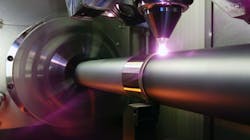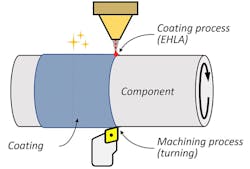The developers of a new, hybrid manufacturing process that combines laser material deposition with turning (or grinding, or milling) claim it allows high-strength materials to be applied quickly and efficiently, and simultaneously machined. The Fraunhofer Institute for Laser Technology’s SMaC process (Simultaneous Machining and Coating) will allow manufacturers or fabricators to produce components that offer extended service life and operator cycles. Those features are notably important for applications in the energy, mobility, and chemical sectors.
Fraunhofer ILT, in Aachen, Germany, part of the Fraunhofer network of industrial research centers, focused on researching and developing laser technologies for manufacturing and production.
The SMaC process combines additive manufacturing and mechanical processing to achieve corrosion and wear protection, and to create functional surfaces quickly and with reduced tool wear. Further, it offers economic and technological advantages in the production process, particularly when applying difficult-to-machine, high-strength coatings.
Coatings help to protect components from various types of damage and wear, and they improve the physical or chemical properties of component surfaces, or give them specific functional qualities.Also, coatings can conserve energy in some applications, thanks to their insulating or reflecting properties.
Cutting coating process time
“We have combined mechanical machining with extreme high-speed laser material deposition EHLA (Extreme High Speed Laser Application) in a single process step,” according to Viktor Glushych, head of the Coating LMD and Heat Treatment group at Fraunhofer ILT. “This allows us to shorten processing times significantly.”
Depending on the requirements of the profile and coating material, the process time can be reduced by more than 60%, according to the developers.
SMaC solves a fundamental problem of high-strength protective coatings that seal parts against corrosion and wear: Harder coatings provide better protection, but the post-processing steps become more complex accordingly. SMaC uses residual heat generated in the EHLA process.
Immediately after laser material deposition, the coating materials exhibit only a fraction of their hardness because there is residual heat of several hundred degrees Celsius. In mechanical processing, which takes place in parallel, the tool can be operated at higher cutting speeds because the coating material is softer when it is processed immediately after its deposition.
“With SMaC, we can apply corrosion- and wear-resistant coatings economically,” Glushych detailed. “We achieve significantly higher surface qualities and potentially longer tool life than with the usual sequential machining.” The EHLA process can be used to process high-strength coating materials – even high-entropy alloys or metallic glass, which can hardly be machined using conventional methods.
Wide application range
SMaC allows users to coat components in a process that is productive, economical, and versatile. There are also ecological advantages to the new process because components can remain undamaged for significantly longer, so service life is extended.
“SMaC decisively extends the service life, operating cycles and maintenance intervals of components, assemblies, and entire machines,” according to Glushych. “This increases the raw material and energy efficiency of the components and minimizes machine downtimes.”
Fewer spare parts mean less raw material usage, less maintenance, less transport and warehousing. For many companies, this means they can work more independently and plan more reliably. In theory, SMaC would help some companies counter the very long delivery times for metal components that have been so much of a concern in recent years.
“SMaC is efficient and saves energy, time as well as resources,” Glushych said. The process is suitable for all applications in which components were previously coated and machined subsequently. For example, it can be used to produce coatings for corrosion and wear protection, coatings with hard and soft magnetic properties, or to produce extremely resistant plain bearing coatings and other functional surfaces.
Some applications for parts treated with the SMaC process include those requiring highly stressed, rotationally symmetrical components – such as might be needed in the energy industry and mobility sectors. In the chemical industry, for example, surfaces have to withstand highly aggressive substances. Similarly, for mining machinery or for tools, SMaC protects against wear.
Glushych proposed that “EHLA coating of brake discs is considered a very promising solution to reduce particulate emissions during braking. With Simultaneous Coating and Machining, we can manufacture certain brake disc coatings faster and more productively.
“Another application we want to test is the production of multi-material coatings in battery technology,” he added.
About the Author
Robert Brooks
Content Director
Robert Brooks has been a business-to-business reporter, writer, editor, and columnist for more than 20 years, specializing in the primary metal and basic manufacturing industries.

